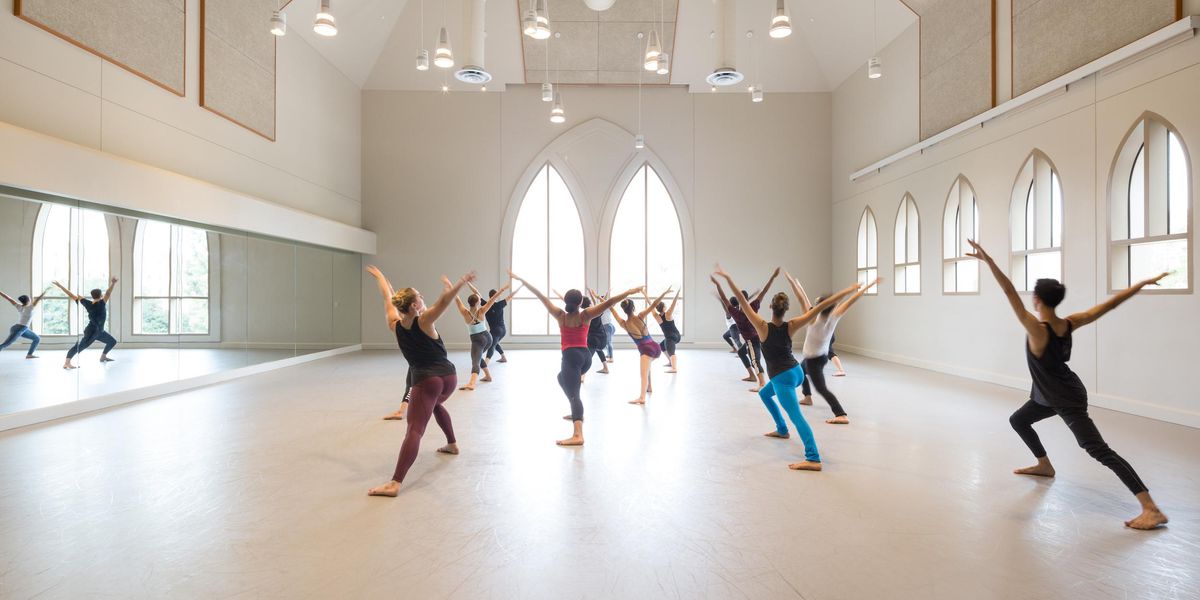So You Want to Go Pro? The Joffrey West is a Window into the Commercial World
As groove-heavy rap echoes through a light-filled studio at California State University, Northridge, jazz choreographer Liz Imperio challenges 30 ballet dancers to stomp, punch and whiplash with even greater intensity. “I want you to soar. I want you to be majestic!” she exclaims, her booming voice seeming to ricochet off the ceiling. “No one is going to hire a scared dancer.”
Bunheads getting down may seem peculiar for a Joffrey Ballet School summer intensive, but Joffrey West is not your typical workshop. Open to dancers of all genres, ages 10 to 25, it’s a six-week immersion in life as a commercial dancer, taught by some of the biggest names in the business. Along with Imperio, who choreographed Jennifer Lopez’s Dance Again concert tour, last year’s faculty included “So You Think You Can Dance” stars tWitch and Chehon Wespi-Tschopp, and Emmy-winning hip-hop choreographers Napoleon & Tabitha D’umo, aka Nappytabs.
Many of the celebrity faculty members are also regulars on the convention circuit, but JW is a rare opportunity to experience their artistry in a smaller setting, and in some cases over a longer span of time. (Last year Imperio taught for two weeks, while Nappytabs led just two classes.) Attendees also meet talent agents from L.A. dance agencies, who give seminars about the business of dance, answer questions and offer advice.
“Because it is in Los Angeles, I wanted to focus on the Hollywood side of dance,” says founding director Alice Alyse. “The dancers experience high-level choreographers who are working on films, commercials and videos, but still get a ballet foundation,” making it a smart option for ballet-trained dancers looking to branch out or hip-hoppers wanting to strengthen their technical base. Former Joffrey dancer (and 2006 “25 to Watch”) Josie Walsh will add her own TV, film and stage experience when she takes the reins for JW’s fourth year this summer.
The blend of classical training and commercial exposure lures dancers from as far away as Argentina, China and Sweden; hopefuls who can’t make it to the JBS audition tour may apply online and submit a video. Solid ballet technique isn’t the only criterion for acceptance, nor even the most important. “We are looking for natural talent, but also discipline, and how well you are trained based on your age,” says Colleen Barnes, a JBS program administrator and faculty member.
Ballet is at the core of the curriculum, so bunheads and b-boys alike take ballet every morning. Classes include technique, pointe, variations, men’s class and partnering (non-pointe dancers may take classes on flat). In any given week, Susan Jaffe, dean of the University of North Carolina School of the Arts dance program, Ballet West artistic director Adam Sklute or Arturo Fernandez, ballet master of Alonzo King LINES Ballet, might teach.
The 9-to-5 day continues with every-thing from commercial jazz and Bolly-wood to Chinese dance and hip-hop. The fast pace simulates the hectic life of a working dancer, who might juggle several projects and dance styles at once as she transitions between video shoots, TV shows, conventions and auditions.
No-nonsense instruction enhances the reality-check experience. “I demand of them what every director would demand,” Fernandez says of his ballet students. “If they want to make dance a career, they need to push themselves more so they’re not just doing steps, they’re communicating something deeper.”
In their hip-hop classes, Nappytabs teach students to adapt their technique for TV and film. “You have a camera in your face when you’re on ‘So You Think You Can Dance.’ Most dancers aren’t used to making that eye contact with the audience,” says Tabitha D’umo. “At the end of class, we paired everybody up and made them perform individually to each other. They didn’t think it would be so hard to dance four feet from someone, but that’s a big part of being a commercial dancer.”
The final three weeks, unofficially called the Performance Track, culminates in an evening show for which 10 instructors choreograph and choose dancers by audition; each student may perform in up to three pieces, and everyone who auditions is cast in at least one.
The Performance Track is a serious commitment, says Spencer Grossman, 21, a freshman dance major at Rutgers University. “This is the first intensive where I’ve had rehearsals at 7 am, then classes and then rehearsals until 7 at night. It’s a lot,” he says. Along with men’s ballet classes, he learned hip-hop and focused on his jazz and flamenco skills. “Hip-hop was a little uncomfortable, but that’s what I’m here for—to become a well-rounded dancer.”
In spite of the demands, Grossman is actually a second-time JW attendee. “This program has really helped me transition into college life, and hopefully into a professional career,” he says. “I’ve gotten to try genres that I wouldn’t normally do, and if I ever wanted to pursue a commercial career, I know where to go and what to do.”
For dancers ready to join the commercial ranks, JW might even jump-start their job search. “There are many times when we see an individual and go, They’ve got ‘it,’ ” says Napoleon D’umo, who keeps an eye out for students at intensives and conventions. “You see them become this amazing, well-rounded commercial dancer, and you can help further them in their career.”
Claudia Bauer is a frequent contributor to
Dance Magazine.
New Joffrey Programs
Starting in 2015, Joffrey Ballet School is launching four new intensives.
- Broadway musical theater, New York, NY (directed by Matthew Prescott)
- Character dance, New York, NY (directed by Larisa Calero)
- Tap Spectacular, Miami, FL (directed by Jo Matos)
- Joffrey World Dance Tour, a tour of ballet training in New York, Florence, Japan and other locations





